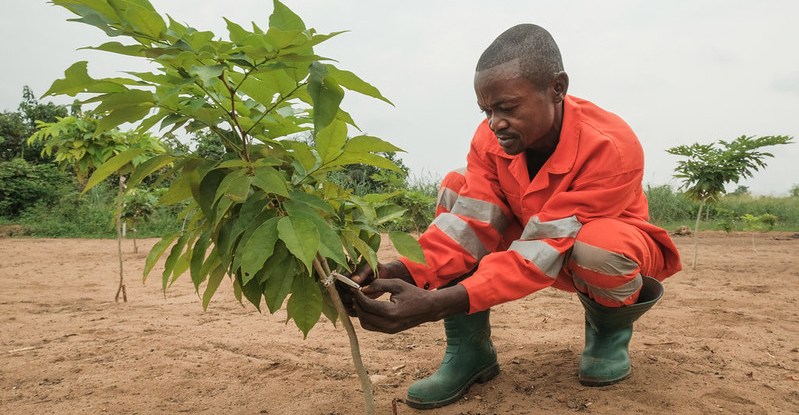By DAVID HENRY
Environmental strategies must maintain focus on greenhouse gas emissions
A man is shown at the Afrormosia growing project at the Compagnie Forestiere et de Transformation in Kisangani, Democratic Republic of Congo. CIFOR/Axel Fassio
Around 40 kilometers south-west of the Ethiopian capital, Addis Ababa, native and exotic trees stand side by side on 8 hectares of the Suba Forest. Surrounded by tall junipers and idyllic mountains, this group of seed orchards is just one of many that serve as incubators for the country’s impressive landscape restoration efforts.
With a tiny carbon footprint by international comparison, this agriculture-dependent East African nation is leading the way in the fight against climate change by implementing a massive tree-planting campaign that is helping to reverse decades of deforestation, drought and land degradation. Ethiopia has pledged to restore 15 million hectares of forests and landscapes by 2030 and has turned local communities into land custodians in the process. Last year, the country highlighted its progress by planting a record 350 million trees in a single day.
Tree planting has become a ubiquitous feature of the environmental zeitgeist in a bid to slow the climate crisis by capturing carbon dioxide and restoring landscapes.
Research has shown that deforestation and land degradation account for $6.3 trillion in lost ecosystem services each year, yet every $1 invested in restoration generates $7–$30 in economic benefits. The opportunity costs offer an added incentive for governments, companies and citizens to meet the goals of the Sustainable Development Agenda, the Bonn Challenge, the New York Declaration on Forests and the African Forest Landscape Restoration Initiative. Yet tree planting is only one component of these broad-based efforts and cannot solve the climate crisis alone.
The Center for International Forestry Research (CIFOR) and World Agroforestry (ICRAF) have identified five global challenges of our time: forest degradation, rapid biodiversity loss, accelerating climate catastrophe, broken food systems, as well as increasing inequalities and inequities. Tree planting plays a key role in addressing these points while supporting around 1.6 billion people who depend on forested areas for their livelihoods. Planting programs also underpin the objectives planned for the U.N. Decade on Ecosystem Restoration 2021–2030.
“A carefully considered tree-planting strategy that includes local communities is essential to protecting the world’s soil, biodiversity and carbon sinks,” says CIFOR Director General Robert Nasi. “Afforestation and reforestation initiatives not only help to mitigate the effects of climate change, but also support the transition to a regenerative economy that casts nature as a partner rather than an obstacle.”
The task is more complex than simply planting seeds wherever there is soil: Success depends on the right tree for the right place and the right purpose.
Read more on the CIFOR – Forest News website.
About Regreening Africa
Regreening Africa is an ambitious five-year project that seeks to reverse land degradation among 500,000 households, and across 1 million hectares in eight countries in Sub-Saharan Africa. By incorporating trees into croplands, communal lands and pastoral areas, regreening efforts make it possible to reclaim Africa’s degraded landscapes.
This story was produced with the financial support of the European Union. Its contents are the sole responsibility of Regreening Africa and do not necessarily reflect the views of the European Union.
